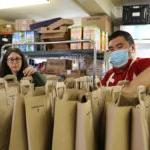BRIDGES Helps Students Meet Their Goals
Summary: The BRIDGES Program teaches life and vocational skills to students with special needs

Bridging the Gap: Transition Program Helps Students with Disabilities Meet Their Goals
Students with disabilities often need extra support with meeting their goals after high school. The BRIDGES Program teaches life and vocational skills to students with special needs. With the help of some dedicated teachers and community partners, these young adults are building confidence and making connections on their road to independence.
From learning to navigate the city to internships to cooking classes and more, students between the ages of 18 and 21 are given the opportunity to become productive and engaged adults through the BRIDGES program.
BRIDGES stands for Building Real-life Independent Daily Living and Gainful Employment Skills. It’s a transition program that supports those who continue to need special education services once they have completed high school. After an application process, students are placed on a BRIDGES pathway where each level is designed to give students the chance to learn and grow based on their own interests and abilities. Students must have an Individualized Education Plan (IEP) to apply.
BRIDGES Pathways
BRIDGES has several programs around the city – each one designed to suit students based on how much support they will need. BRIDGES 1 is for young adults with disabilities who are moderately independent, and who continue to need adaptive, social, daily living, and/or life skills education and support. Students in these programs can handle working a full day – usually in a hospital or similar setting. BRIDGES 1 classes are located at Providence Swedish, Seattle Children’s Hospital, and Providence Mt. St. Vincent in West Seattle.
Kelly Walker runs the class at Swedish Medical Center on First Hill. She said one major benefit of the program is students can experience different types of jobs instead of selecting a single workplace.
“These are young adults who’ve been in high school, who don’t yet know all the environments and settings for jobs out there,” Walker said. “So, instead of trying one job at BRIDGES, students will have a list of jobs that they’ve tried. And will have vocational experiences and different community settings that will help them to choose their eventual job based on experience.”
The students in BRIDGES 2 are provided community-based internship and recreational experiences and are mostly independent after some initial training. Classes are located at Roxhill Annex and Ingraham, Rainier Beach, Nova and Nathan Hale high schools.
Eileen Mizwicki is a special education teacher for BRIDGES 2 at Nova. She said students play a vital role in developing their IEP transition plans and annual goals to meet their long-term transition goals.
“I describe the program as “Adulting 101,” where students have opportunities to learn and apply a myriad of skills encompassing functional academics, communication and social-skills, community access, connection with other same-aged peers, King County Metro independence, and self-awareness and self-advocacy skills,” Mizwicki said.
BRIDGES 3 is for young adults with disabilities who have significant cognitive and adaptive delays that need significant support throughout the day. The emphasis of this program is on instruction in life skills, community inclusion, pre-vocational activities, and volunteering or working in local organizations.
“I have students who require a little bit more support throughout the day to help them do tasks,” said Heidi Leyton, a special education teacher at the Ingraham BRIDGES program. “Some of them use wheelchairs, we have some who are non-verbal and use communication devices.”
Leyton said they spend their days working on life skills and learning to do tasks more independently.
“They might be working on bathroom skills, cooking skills, life skills and then when we are out in the community, we go to different job sites where we might go work in the garden, we might go to work in the food bank.”
Community Partners and Supports
Students typically work on life skills while also holding down several internships in the community. Places like the YWCA Food Bank, Re-Sole 206, and Grocery Outlet allow students to work a few hours a week to practice their work skills. Students report to their job sites, sign in, and get to it. Their jobs run the gamut from Starbucks barista to preparing bags of groceries at a food bank to working in a hospital stocking medical carts. Students gain skills that translate across multiple career fields.
But it’s not all work and no play. Students go on community outings each week to places like the library, the University of Washington and Summit Community Center (SCC).
SCC was created to support young adults ages 18-35+ with intellectual or developmental disabilities and those considered neurodivergent. Miguel Smith is a social worker at SCC and has witnessed the growth of BRIDGES students.
“We’re still seeing folks coming out of the COVID time … slowly reintegrating back into the community. That is still a hard transition for them,” Smith said. “So, adding another setting – whether that’s employment or a community setting – has created in them a new confidence that they hadn’t experienced yet. We’re seeing a lot of folks take control over their lives, full autonomy and independence in their choices they want to have.”
Young adults in any of the BRIDGES programs can also get help with applying for government aid and finding employment that suits their abilities. Students get help with applying with Developmental Disabilities Administration and Department of Vocational Rehabilitation to foster a smooth transition from Seattle schools’ services to adult service provider supports.
It’s never too early to start thinking about enrolling. Families are encouraged to start planning as early as freshman year.



